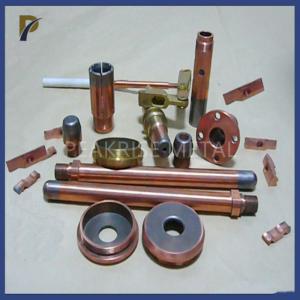
Add to Cart
Tungsten Copper Alloy Connector
1. Description Of Tungsten Copper Alloy Connector:
Tungsten-copper connectors are mostly found in pipes, which connect the most vulnerable parts of the pipe by nesting or welding to improve performance. In addition, there are many forms such as tungsten copper rivets, tungsten copper bolts, tungsten copper electrodes, pins and so on.
2. Size and Performance Of Tungsten Copper Alloy Connector:
Tungsten Copper Alloy connector process as per customer's drawing.
| Performance | Density g/cm3 | Thermal expansion coefficient 10-6/℃ | Thermal conductivity w/(m·k) | Heat capacity J/(kg·℃) | Elastic ModulusGPa | Poisson density | Melting point ℃ | Strength MPa |
| W | 19. 25 | 4. 5 | 174 | 136 | 411 | 0. 28 | 3410 | 550 |
| Cu | 8. 92 | 16. 6 | 403 | 385 | 145 | 0. 34 | 1083 | 120 |
| Grade | Density (g/cm3) | Thermal conductivity | Thermal expansion coefficient |
| WCu10 | 17.0 | 160 | 6.2 |
| WCu15 | 16.2 | 170 | 6.9 |
| WCu20 | 15.4 | 180 | 7.4 |
| WCu25 | 14.7 |
200 | 8.0 |
| WCu30 | 14.1 | 220 | 8.8 |
3. Principle Of Tungsten Copper Alloy Connector:
1). Shape locking: It is the mutual clamping effect formed by the shape of the connected parts or the additional connecting parts, and the force that hinders the relative movement between the connected parts is generated on the joint surface;
2). Friction locking: two or more connected parts are pressed together, and positive pressure is generated on the joint surface. When there is a relative movement trend between the connected parts, the relative movement between the connected parts is blocked on the joint surface. friction force or friction torque;
3). Material locking: use the molecular bonding force between the material and the connected parts to connect them, such as welding and gluing.


4.Classification Of Tungsten Copper Alloy Connector:
Tungsten copper alloy connectors can be divided into three classification: